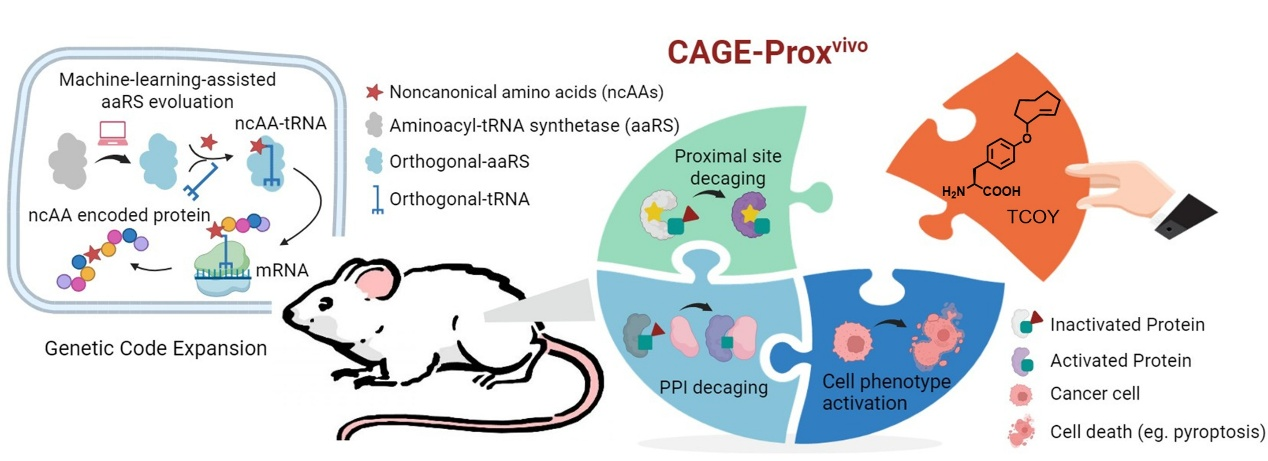Peking University, June 1, 2025: To address the challenge of controlling protein activation in living animals for gain-of-function studies, researchers from Peking University led by Professors Chen Peng and Wang Chu recently developed CAGE-Proxvivo, a computer-aided proximal decaging strategy for on-demand protein activation and modulation of protein–protein interactions in living mice. This work establishes a universal platform for time-resolved biological studies and on-demand therapeutic interventions in vivo. These findings were published in
Cell on May 27, 2025, under the title "Machine-Learning-Assisted Universal Protein Activation in Living Mice."
Why it matters:
In-situ regulation and dynamic analysis of biologically active molecules are crucial for unveiling life processes and understanding disease mechanisms. The previously developed protein activation technology CAGE-Prox utilizes bioorthogonal cleavage reactions to install functional switches for various protein families, enabling regulation of protein function beyond specific activation sites. This allows for universal protein activation with high spatial and temporal resolution, offering a novel strategy for dynamically analyzing protein mechanisms. However, this method relies on UV light, which has limited tissue penetration, thereby restricting its application in living animals.
Methodology:
The research teams employed the machine-learning-assisted evolution of aminoacyl-tRNA synthetase to successfully incorporate chemically caged amino acids into rationally designed “decaging sites”, thereby transiently blocking target protein function. Functionality could then be restored in situ via a small-molecule-triggered bioorthogonal cleavage reaction. This method demonstrates broad applicability, from activating proteins of interest to cell-type-specific modulation of distinct phenotypes in living systems. Beyond the “active-pocket” decaging, CAGE-Proxvivo also enables precise control of protein-protein interactions, for example by a “gated” anti-CD3 antibody that permits chemically regulated T-cell recruitment and activation at tumor sites.
Key findings:
-This work demonstrated that CAGE-Proxvivo, a machine-learning-assisted platform, enables precise, on-demand protein function and interaction activation in living animals through incorporation of non-canonical amino acid at selected "decaging site".
-The research confirmed that CAGE-Proxvivo allows tumor cell-specific activation of pyroptosis, which stimulates a robust anti-tumor immune response, showcasing its potential in immunotherapy.
-The team successfully developed a bioorthogonally "gated" anti-CD3 antibody that enables chemically controlled T-cell engagement at tumor sites, providing a novel approach to regulate immune responses with high specificity.
This groundbreaking study presents CAGE-Proxvivo as a universal platform for precise protein activation and modulation of protein-protein interactions in vivo, enabling "gain-of-function" studies and targeted therapeutic interventions.

CAGE-Proxvivo technology: Trans-cyclooctene-caged tyrosine (TCOY) is site-specifically incorporated into a protein via machine-learning-assisted genetic code expansion, temporarily masking protein activity. The protein is then reactivated through IEDDA reaction-mediated bioorthogonal decaging within its catalytic pocket in vivo in mice.
This article is featured in the "Why It Matters" series. More from this series
Read more: https://www.cell.com/cell/fulltext/S0092-8674(25)00517-3
Written by: Wang Chu, Chen Peng
Edited by: Zhang Jiang
Source: College of Chemistry and Molecular Engineering, Peking University
